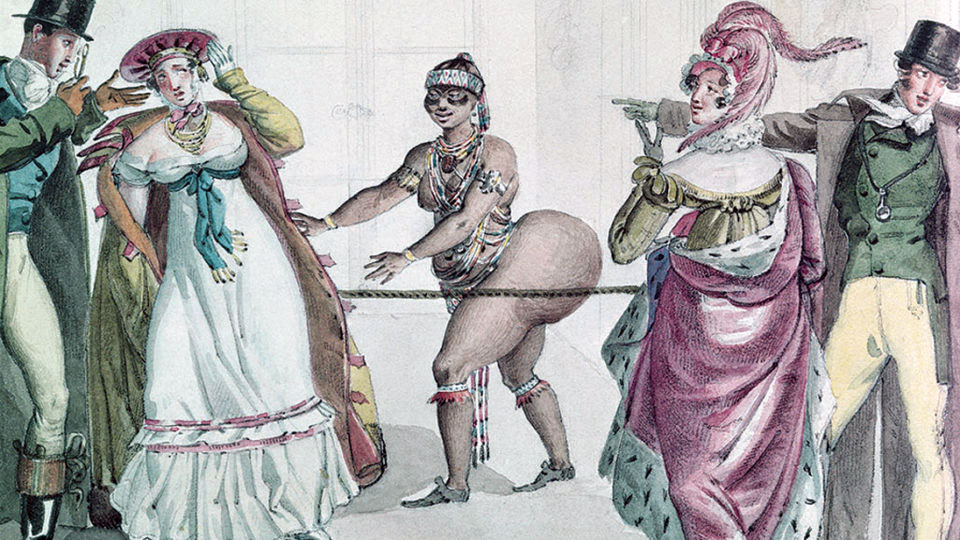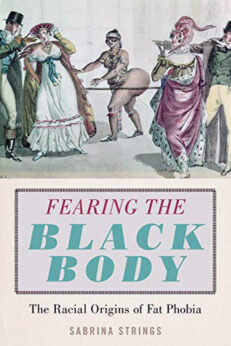
One author is using history to expose some of the racist roots in public healthcare. In Fearing the Black Body: The Racial Origins of Fat Phobia author Sabrina Strings, Ph.D., argues that fat phobia isn’t about health at all, but rather a means of using the body to validate race, class, and gender prejudice. The book is a history lesson spanning hundreds of years that may make readers question some of the rhetoric they’ve taken to heart surrounding what (and who) is allowed to embody the “normal” physique, and why that is.
Fat phobia, defined as shaming and discriminating against those with larger bodies, is often connected to what some in the medical field, and also mainstream media, call the “obesity epidemic” in the United States. There’s a notion that people considered over “normal” weight are more prone to adverse health conditions and higher mortality due to their size. One could argue that this fear of fatness has helped to make the health and fitness industry worth billions of dollars, as consumers go after all the latest trendy diets and workouts to achieve the thin ideal. The research conveyed in Fearing the Black Body posits that perhaps we as a country have been bamboozled.
Why we think “thin is in” may have nothing to do with health, but more to do with the trans-Atlantic slave trade and class warfare. That may sound like a stretch, but Dr. Strings makes a compelling argument by presenting facts and historic documents that are hard not to take into consideration.
 Fearing the Black Body traces the vilification of fatness in the West to the slave trade, colonists, and race science propaganda. Dr. Strings explains that by the 19th century, white well-to-do elites sought ways to differentiate themselves from the poor and non-white. The author points out that skin color became an inefficient way to sort the population due to intermingling.
Fearing the Black Body traces the vilification of fatness in the West to the slave trade, colonists, and race science propaganda. Dr. Strings explains that by the 19th century, white well-to-do elites sought ways to differentiate themselves from the poor and non-white. The author points out that skin color became an inefficient way to sort the population due to intermingling.
Through racist science propaganda, Black people were categorized as being inherently “voracious” (eager to consume food and sex), while eastern and southern Europeans (Russian Jews, Southern Italians, and also the Irish) immigrating into the U.S. were also seen as often having larger bodies. Basically, thin bodies of northern and western Europeans were upheld as the ideal, while the often larger bodies of Africans, along with eastern and southern Europeans, were used to signify inferiority.
The book argues that this was a tactic used in order to uphold the “purity” of the white Anglo race through degrading Black people and newly migrated “other” Europeans.
There’s a lot to take in with this book, as the information is dense, but there are some interesting highlights that will give readers hearty food for thought.
The author makes it clear from the very beginning that what we may know as the norm now has not always existed. In fact, in relation to thinness being the ideal, it may even be a fairly new concept. Dr. Strings uses biographies of influential figures and events to display this. Readers are reminded that the only constant in human history is change—for better or worse.
The second highlight, and perhaps the most damning, is the focus on race (or rather, racist) science and its influence in the modern healthcare system. Fearing the Black Body focuses on hundreds of years of racist rhetoric that masqueraded as impartial research that still taints the way we look at health today.
The author lays out a number of revelations that may not be common knowledge to non-historians. For instance, the Body Mass Index (BMI) is the measurement many of us are familiar with in determining if we are underweight, normal weight, or overweight. It is a weight-to-height ratio used by many health care providers, insurance companies, and the scientific community.
But what if I told you that the BMI has racist origins and may not be as accurate as we are made to believe? Fearing the Black Body does just that. It turns out the BMI was a scale created using data from predominantly European men to measure weight in different populations. That means that the numbers all of us are told to fit into don’t even have all of us, or most of us, in mind.
The book goes further to point out that when Black people were taken into consideration they were often deemed problematic and the epitome of unhealthy—such as the infamous “Hottentot Venus” Sara Baartman, an African woman who was paraded about like a zoo attraction for white people to gawk at in the 1800s.
Fast forward to today and Dr. Strings writes how the bodies of larger Black women are still being used as the symbolic “other” to be gawked at and spoken about derisively. The author explains how Black women have become one of the involuntary symbols for the so-called obesity epidemic plaguing the nation, an epidemic that should be noted is not completely agreed upon by everyone in the medical community.
These parts of the book make for some riveting and at times shocking reading. People who love history will enjoy it for that.
Yet, the book does have some shortcomings. Dr. Strings does a fine job of collecting all of this material for the reader to take in, but her voice gets lost in all the facts and data. At times Fearing the Black Body reads like a collection of biographies or a straightlaced textbook. This could be offputting for readers wanting an author to walk them through the material a bit more, and explain which parts of the information they should be paying attention to and why.
The other issue is that the book feels like it stops just as things hit the modern age. After Dr. Strings has taken us on this over 300-year journey, she stops short before we’re able to really lay into all the ways this history has truly impacted the health inequalities in the United States. It feels like a missed opportunity to dive even deeper into a very current problem.
The Centers for Disease Control and Prevention (CDC) explains on its website that “racism—both interpersonal and structural—negatively affects the mental and physical health of millions of people, preventing them from attaining their highest level of health,” and that these “social determinants of health” are “key drivers of health inequities within communities of color, placing those within these populations at greater risk for poor health outcomes.”
The U.S. is no stranger to inequality. From its inception as a nation, there’s been a complex relationship with the truthfulness behind its famous saying “liberty and justice for all.” The wealth gap between the rich and the working poor grows larger every year. Yet, there exists an insidious companion to that injustice in the form of health disparities. Recent studies have shown it is fueled by racism. If we are to go by the information we get in Fearing the Black Body, we can now understand that this is not a new phenomenon.
Dr. Strings has made an important contribution with her book because it shows us just how deep the roots of racism go when addressing the often outdated and detrimental ways the healthcare profession engages with Black communities and other non-white populations. Of course, there are so many other elements that come into play when it comes to these disparities, but Fearing the Black Body makes a strong argument that the focus shouldn’t be on the (flawed) socially engineered weight standard, but rather on real work to improve health outcomes in communities that the medical profession has a tendency to not hold in priority.
There’s a lot of work to be done to deal with systemic racism and bias in healthcare, but reading books like Fearing the Black Body helps us to understand just how deep the problem goes.
Fearing the Black Body: The Racial Origins of Fat Phobia
By Sabrina Strings Ph.D.
New York University Press, 2019, 304 pp.
Hardcover, paper, and e-book editions
Available from the publisher here.

MOST POPULAR TODAY

High Court essentially bans demonstrations, freedom of assembly in Deep South

UN warns that Israel is still blocking humanitarian aid to Gaza

Resource wars rage in eastern Congo, but U.S. capitalism only sees investment opportunity

U.S. imperialism’s ‘ironclad’ support for Israel increases fascist danger at home







Comments